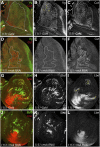Adult Muscle Formation Requires Drosophila Moleskin for Proliferation of Wing Disc-Associated Muscle Precursors
- PMID: 28249984
- PMCID: PMC5419470
- DOI: 10.1534/genetics.116.193813
Adult Muscle Formation Requires Drosophila Moleskin for Proliferation of Wing Disc-Associated Muscle Precursors
Abstract
Adult muscle precursor (AMP) cells located in the notum of the larval wing disc undergo rapid amplification and eventual fusion to generate the Drosophila melanogaster indirect flight muscles (IFMs). Here we find that loss of Moleskin (Msk) function in these wing disc-associated myoblasts reduces the overall AMP pool size, resulting in the absence of IFM formation. This myoblast loss is due to a decrease in the AMP proliferative capacity and is independent of cell death. In contrast, disruption of Msk during pupal myoblast proliferation does not alter the AMP number, suggesting that Msk is specifically required for larval AMP proliferation. It has been previously shown that Wingless (Wg) signaling maintains expression of the Vestigial (Vg) transcription factor in proliferating myoblasts. However, other factors that influence Wg-mediated myoblast proliferation are largely unknown. Here we examine the interactions between Msk and the Wg pathway in regulation of the AMP pool size. We find that a myoblast-specific reduction of Msk results in the absence of Vg expression and a complete loss of the Wg pathway readout β-catenin/Armadillo (Arm). Moreover, msk RNA interference knockdown abolishes expression of the Wg target Ladybird (Lbe) in leg disc myoblasts. Collectively, our results provide strong evidence that Msk acts through the Wg signaling pathway to control myoblast pool size and muscle formation by regulating Arm stability or nuclear transport.
Keywords: Drosophila melanogaster; Moleskin; indirect flight muscles; proliferation.
Copyright © 2017 by the Genetics Society of America.
Figures








Similar articles
-
FGF signaling promotes myoblast proliferation through activation of wingless signaling.Dev Biol. 2020 Aug 1;464(1):1-10. doi: 10.1016/j.ydbio.2020.05.009. Epub 2020 May 21. Dev Biol. 2020. PMID: 32445643 Free PMC article.
-
Myoblast cytonemes mediate Wg signaling from the wing imaginal disc and Delta-Notch signaling to the air sac primordium.Elife. 2015 May 7;4:e06114. doi: 10.7554/eLife.06114. Elife. 2015. PMID: 25951303 Free PMC article.
-
A molecular basis for transdetermination in Drosophila imaginal discs: interactions between wingless and decapentaplegic signaling.Development. 1998 Jan;125(1):115-24. doi: 10.1242/dev.125.1.115. Development. 1998. PMID: 9389669
-
Forces shaping the Drosophila wing.Mech Dev. 2017 Apr;144(Pt A):23-32. doi: 10.1016/j.mod.2016.10.003. Epub 2016 Oct 23. Mech Dev. 2017. PMID: 27784612 Review.
-
Indirect flight muscles in Drosophila melanogaster as a tractable model to study muscle development and disease.Int J Dev Biol. 2020;64(1-2-3):167-173. doi: 10.1387/ijdb.190333un. Int J Dev Biol. 2020. PMID: 32659005 Review.
Cited by
-
Drosophila, an Integrative Model to Study the Features of Muscle Stem Cells in Development and Regeneration.Cells. 2021 Aug 17;10(8):2112. doi: 10.3390/cells10082112. Cells. 2021. PMID: 34440881 Free PMC article. Review.
-
Baf-mediated transcriptional regulation of teashirt is essential for the development of neural progenitor cell lineages.Exp Mol Med. 2024 Feb;56(2):422-440. doi: 10.1038/s12276-024-01169-3. Epub 2024 Feb 19. Exp Mol Med. 2024. PMID: 38374207 Free PMC article.
-
Mechanical control of nuclear import by Importin-7 is regulated by its dominant cargo YAP.Nat Commun. 2022 Mar 4;13(1):1174. doi: 10.1038/s41467-022-28693-y. Nat Commun. 2022. PMID: 35246520 Free PMC article.
-
Genetic Control of Muscle Diversification and Homeostasis: Insights from Drosophila.Cells. 2020 Jun 25;9(6):1543. doi: 10.3390/cells9061543. Cells. 2020. PMID: 32630420 Free PMC article. Review.
-
Piwi reduction in the aged niche eliminates germline stem cells via Toll-GSK3 signaling.Nat Commun. 2020 Jun 19;11(1):3147. doi: 10.1038/s41467-020-16858-6. Nat Commun. 2020. PMID: 32561720 Free PMC article.
References
-
- Anant S., Roy S., VijayRaghavan K., 1998. Twist and Notch negatively regulate adult muscle differentiation in Drosophila. Development 125: 1361–1369. - PubMed
-
- Bate M., 1990. The embryonic development of larval muscles in Drosophila. Development 110: 791–804. - PubMed
-
- Bate M., Rushton E., Currie D. A., 1991. Cells with persistent twist expression are the embryonic precursors of adult muscles in Drosophila. Development 113: 79–89. - PubMed
-
- Bejsovec A., 2006. Flying at the head of the pack: Wnt biology in Drosophila. Oncogene 25: 7442–7449. - PubMed
MeSH terms
Substances
Grants and funding
LinkOut - more resources
Full Text Sources
Other Literature Sources
Molecular Biology Databases

